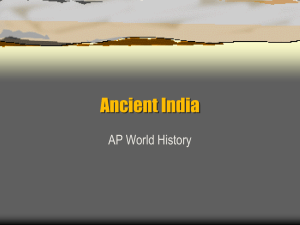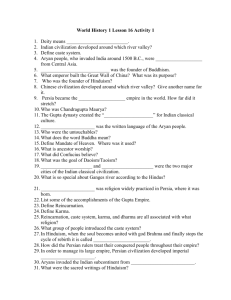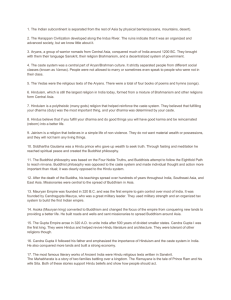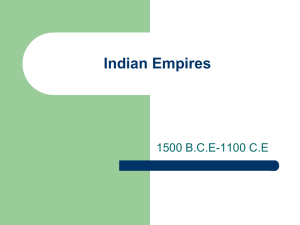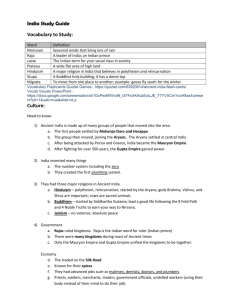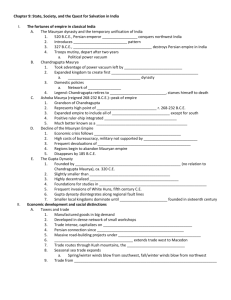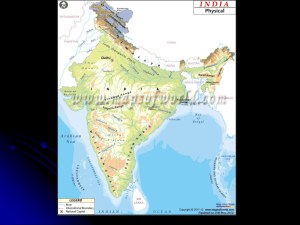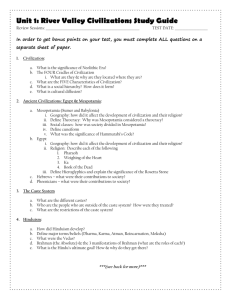AP World History: Ancient India
advertisement
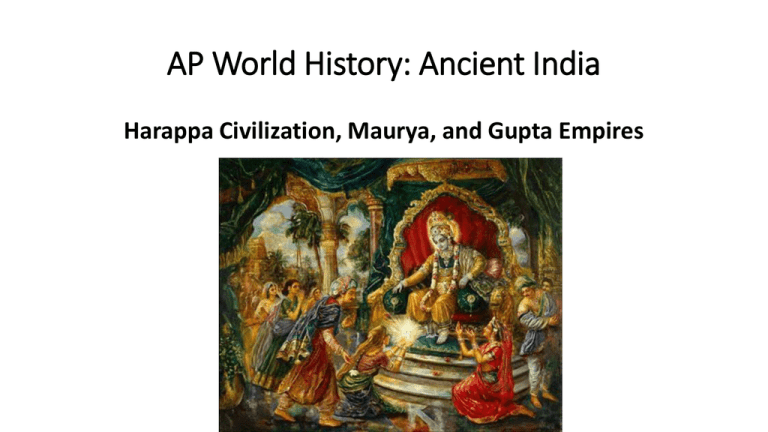
AP World History: Ancient India Harappa Civilization, Maurya, and Gupta Empires Presentation Outline 1. 2. 3. 4. 5. 6. 7. Geography of India Harappa Civilization Aryan Invasion Caste System Hinduism Maurya Empire Gupta Empire 1. Geography of Ancient India • The Indian subcontinent has the following geographic features which have contributed to the development of civilization • Monsoonal rains can help sustain life but can also cause disastrous flooding • Three River valleys: Indus, Brahmaputra, and Ganges rivers • To North: Impassable Himalayas • To East: Passable low hills • To Northwest: Passable Hindu Kush, Khyber Pass • To West: Arabian Sea 2. Harappa Civilization • 3000 B.C.E- 1500 B.C.E • Located along the Indus River Valley in modern day Pakistan/India • Wheat and barley were cultivated in Indus valley • Harappa and Mohenjo-daro • • • • Possibly served as twin capitals Each city had a fortified citadel and a large granary Broad streets, market places, temples, public buildings Standardized weights, measures, architecture, bricks • Specialized labor and trade • Domestic trade, items inc. pottery, tools, metals • Trading with Mesopotamians about 2300 to 1750 B.C.E • After years of natural disasters (earthquakes and flooding) Harappa Civilization began to decline • People began to flee their cities • Unable to defend their civilization, Harappa civilization was vulnerable to invaders 3. Aryan invasion • Between 1750 and 1500 B.C.E Aryan invaders from Central Asia and Eastern Europe invaded India • They brought with them a new language (Sanskrit), a social order (caste system), and a new religion (Hinduism) 4. Caste System • Caste and varna • Caste: • Hereditary, unchangeable social classes • Sanskrit word varna, "color," referring to social classes • Social distinctions based on racial skin colors • Social distinctions in the late Vedic Age • Four main varnas, recognized after 1000 B.C.E. • brahmins (priests) • kshatriyas (warriors and aristocrats: rulers) • vaishyas (cultivators, artisans, and merchants) • shudras (landless peasants and serfs) • Later, the category of the pariah (untouchables) was added Caste and social mobility • Caste system was capable of accommodating social change • Social mobility was very difficult but still possible • Foreign peoples could find a place in society of the castes 5. Hinduism The Upanishads • • Works of religious teachings, 800 to 400 B.C.E. The religious forums: dialogues between disciples and sages Brahman: the universal soul • • Brahman was the only genuine reality Highest goal: to escape reincarnation and join with Brahman Atman: The individual self-soul that is part of Brahman Teachings of the Upanishads • • • • Samsara: An individual soul was born many times Dharma: Caste duties Karma: specific incarnations that a soul experienced Moksha: permanent liberation from physical incarnation Religion and Vedic Society • • • • Samsara and karma reinforced social hierarchy Upanishads were also spiritual and intellectual contemplations Taught to observe high ethical standards Respect for all living things, a vegetarian diet Hindu gods Hinduism is a polytheistic religion 6. Mauryan Empire • 322 B.C.E to 185 B.C.E Chandragupta united India in 322 B.C.E after defeating the Persians (from modern day Iran) • Divided empire into districts and collected taxes • Enforced strict adherence to caste system Chandragupta Asoka took over as ruler of Maurya around 252 B.C.E • converted to Buddhism • Dedicated to building roads and improving education Asoka After Asoka’s death, the Maurya Empire weakens and India is divided into separate states 7. Gupta Empire • A revived Indian Empire was established under Chandra Gupta I in 320 C.E. • The Gupta Empire allowed a degree of religious toleration, allowing both Hinduism and Buddhism to coexist • Extensive trade networks were established • Many scientific and artistic achievements Extensive trade with other empires Extensive Trade: 4c spices gold & ivory Gupta Art Greatly influenced Southeast Asian art & architecture. 500 healing plants identified 1000 diseases classified Printed medicinal guides Plastic Surgery Gupta Achievement s Kalidasa Literature Medicine Inoculations C-sections performed Decimal System Gupta India Mathematics Concept of Zero PI = 3.1416 Solar Calendar Astronomy The earth is round • Gupta India declined around 400 C.E. during the White Hun invasions • India would again be divided into separate states and only later unified again after Muslim invaders in the 7th and 8th centuries
